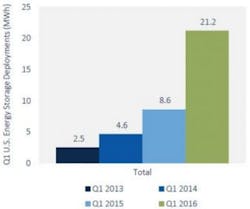ESA: Longer-Duration Shift Shown in U.S. Energy Storage Growth
Per a report issued March 7, 2017, by the Energy Storage Association (ESA), significant growth is occurring in energy storage in the U.S. and includes a shift toward longer-duration storage use cases. Specifically, record-breaking growth in energy storage deployments in 4Q 2016 in the U.S. was largely due to an increase in longer-duration storage facility installations, notably in California.
In contrast, according to the new report issued by the ESA, prior growth in storage was mainly driven by shorter-duration storage applications, including frequency-response applications in the PJM region.
More detailed results are available in the ESA report, In Shift to Longer-Duration Applications, US Energy Storage Installations Grow 100% in 2016.
March 7, 2017 Review of U.S. DOE Global Energy Storage Database
An independent way of assessing the trend findings from ESA for 2015 to 2016 projects involves data reported by storage project personnel to the Department of Energy under the DOE Global Energy Storage Database.
The DOE data for commissioned storage projects in the U.S. with status listed as “Operational” involving electrochemical storage showed confirms the more detailed and comprehensive results summarized in the ESA report. While the DOE data shows only those storage projects participants reported into the system, both average and total duration (hours) as well as energy stored (MWh) increased two- to three-fold between 2015 and 2016. And, as expected, lithium-ion based battery chemistries still dominate the field, at more than 80% of all chemistries on a project-by-project basis.
Save
About the Author
Peter Arvan Manos
Utility Industry Analyst
Peter Manos is Director of Research for Electric Power & Smart Grid, on the Energy Sector team at ARC. He analyzes the latest trends across People, Process, and Technology to uncover business and digital transformation best practices for electric, gas, and water utilities. He can be reached at [email protected]

